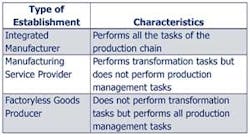With U.S. government statisticians planning to change how they count “factoryless goods producers,” and companies reincorporating overseas to escape high tax rates, it’s an, uhm, interesting time to compile a list of the largest U.S. manufacturers.
Truth is, though, IndustryWeek has grappled with the question, “What’s a manufacturer?” at least since we published the inaugural IndustryWeek 1000, our first annual list, in 1996. The difficulty back then arose from some questions we had when we dug into the government data we were using to build the list.
We started with a simple definition: “Companies with a majority of their business falling under a manufacturing SIC,” but then added “computer software companies whose primary business is the manufacture of software programs.” Our reason for including the software companies was simple: Those companies produced—and earned a majority of their revenue from--manufactured goods, even though they weren’t included in the manufacturing SICs. (The NAICs replaced SICs in 1997.)
Large integrated oil and mining companies also were a bit of a challenge. In the first list, we included only those primarily engaged in refining and production. In later years, we, ahem, refined our data gathering and our list to include the integrated companies that derived a majority of their revenues from refining. Afterall, they produce—and earning a majority of their revenue from—making a manufactured good.
Always a big question was whether we should include companies that didn’t own a factory, what the government statisticians call “factoryless goods producers.” For us, the answer was simple: Yes.
A few years back, we were taken to task for this, specifically for naming Apple Corp. as an IndustryWeek 50 Best Manufacturer. The charge: Apple outsourced all assembly and production; how could we call them a manufacturer? Bottom line for IndustryWeek: Companies that derive most of their revenue from making manufactured goods are manufacturers. Period.
| You can read a quick backgrounder about the proposed revisions to factoryless goods producers in The Federal Register: Vol. 79; No. 99. Thursday; May 22, 2014. |
Thankfully, U.S. government statisticians are catching up to us, putting to rest the absurd notion that a company that controls, but does not own, production is something other than a manufacturer. The Office of Management and Budget (OMB) through its Economic Classification Policy Committee (ECPC) is seeking comments and proposals on how to reclassify factoryless goods producers as manufacturers.
Comments must be in writing and received no later than July 2014; find details in The Federal Register: Vol. 79; No. 99. Thursday; May 22, 2014.
Now however, just as factoryless goods producers are being added to the government count, other U.S. companies are disappearing from the IndustryWeek list because they are reincorporating to other countries to avoid taxes. In many cases, these companies have made few changes to their U.S. footprint—and even continue to maintain primary corporate offices in the U.S. For our list-making purposes, the answer, again, is simple. We count them where they are incorporated.
It’s a truism that what gets measured gets managed. Not as often recognized is that how things are counted affects what gets measured. The seemingly simple act of categorizing that which is to be measured affects the outcome, as well as the decisions are made from it.
The miscounting and confusion about what we mean when we talk about manufacturing, I believe, has led too many public policy and business leaders to devalue the sector. This fresh look at how we categorize factoryless goods producers and the fallout from fleeing companies is a chance to take another look. And it has the added benefit of helping us get closer to getting it right.
I hope you agree.





